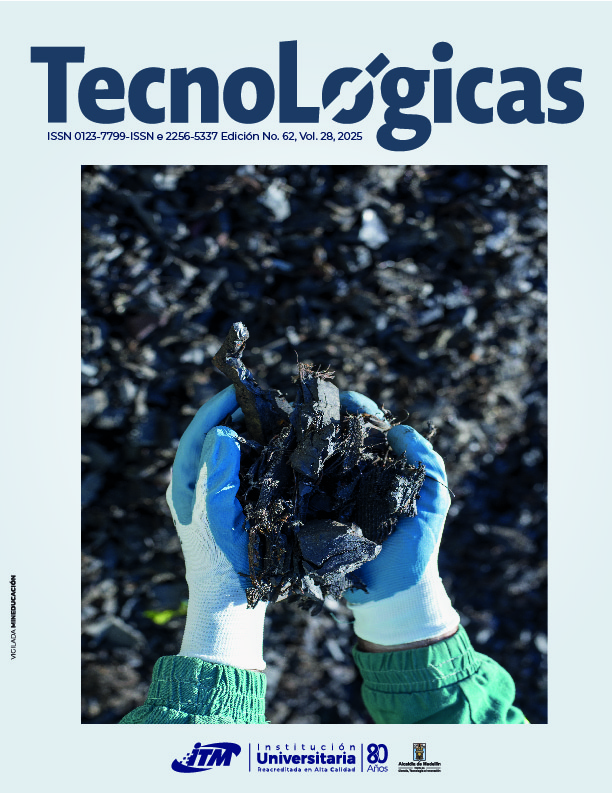Estabilidad por falla de fondo en excavaciones circulares con muros diafragma en arcillas sobreconsolidadas: análisis paramétrico y método simplificado
Resumen
Recientemente se han implementado métodos sin zanja (trench-less) en obras de saneamiento en Bogotá, Colombia para instalar colectores de más de 3 m de diámetro. Estos emplean pozos circulares profundos sostenidos por muros diafragma fundidos in situ, junto con anillos de concreto, para lanzar y recibir equipos de tunelación. Las condiciones axisimétricas exigen definir con precisión el empotramiento de los muros y verificar la estabilidad ante falla de fondo en arcillas sobreconsolidadas. Esta investigación tuvo como objetivo realizar una evaluación del factor de seguridad frente a la falla de fondo mediante un análisis paramétrico para proponer un método simplificado de evaluación. La metodología empleada consistió en la realización de simulaciones numéricas con elementos finitos, considerando variaciones en el diámetro de la excavación, su altura libre, y la profundidad de empotramiento de los muros diafragma en un perfil de arcillas del suroccidente de Bogotá caracterizado a partir de un sondeo de piezocono con medición de poros (CPTU, por sus siglas en inglés). Los resultados indicaron que el factor de seguridad depende principalmente de las propiedades geométricas de la excavación, de la profundidad de empotramiento del sistema de contención y de la resistencia no drenada de la arcilla bajo el fondo de la excavación. Finalmente, con base en los hallazgos de la modelación paramétrica, se concluye que el efecto de la sobreconsolidación superficial en el factor de seguridad puede expresarse en una ecuación semiempírica incorporando de un coeficiente de ajuste (a), siendo este efecto más significativo en excavaciones de diámetro reducido. Estos resultados permiten mejorar la evaluación de la estabilidad de excavaciones y optimizar estrategias constructivas, favoreciendo soluciones más seguras, sostenibles y resilientes en el diseño de obras subterráneas.
Referencias bibliográficas
F. Cai, K. Ugai, and T. Hagiwara, “Base Stability of Circular Excavations in Soft Clay,” J. Geotech. Geoenviron. Eng., vol. 128, no. 8, pp. 702-706, Aug. 2002. https://doi.org/10.1061/(ASCE)1090-0241(2002)128:8(702)
A. T. C. Goh, “Basal heave stability of supported circular excavations in clay,” Tunn. Undergr. Space Technol., vol. 61, pp. 145-149, Jan. 2017. https://doi.org/10.1016/j.tust.2016.10.005
C.-F. Hsu, Y.-H. Tsai, Y.-R. Chen, Y.-F. Li, and S.-L. Chen, “Normalized analysis of deformation for deep excavation diaphragm walls under different neighboring building conditions,” Res. Eng., vol. 22, p. 102155, Jun. 2024. https://doi.org/10.1016/j.rineng.2024.102155
H. Li, M. Huang, J. Yu, Y. Li, and Y. Guo, “Three-dimensional solution for braced excavation-induced ground settlement,” Comput. Geotech., vol. 172, p. 106460, Aug. 2024. https://doi.org/10.1016/j.compgeo.2024.106460
T. Boonyarak, A. Yadana Aung, V. Kamchoom, and Z. Zaw Aye, “Diaphragm wall lateral movement in deep excavations in Bangkok clays: impacts and influencing factors,” Can. Geotech. J., vol. 62, pp. 1-16, Jun. 2024. https://doi.org/10.1139/cgj-2024-0058
J. S. Shiau, M. S. Sams, J. Zhang, and R. J. Kemp, “Settlement analyses of underground circular tunneling in soft clay,” In Geotechnical Aspects of Underground Construction in Soft Ground, C. Yoo, S. W. Park, B. Kim, and H. Ban, Eds., Seoul: Korean Geotechnical Society-CRC Press, 2014, pp. 347-352. https://www.issmge.org/uploads/publications/6/20/2014_055.pdf
S. Y. Lam, “Ground movements due to excavation in clay: physical and analytical models,” Ph.D. Thesis, University of Cambridge, Cambridge, England, 2010. https://doi.org/10.17863/CAM.13985
R. P. Cunha, and H. G. Poulos, “Importance of the Excavation Level on the Prediction of the Settlement Pattern from Piled Raft Analyses,” Soils Rocks, vol. 41, no. 1, pp. 91-99, Aug. 2018. https://www.soilsandrocks.com/sr-411091099
S. C. Jong, and D. E. L. Ong, “A novel Bayesian network approach for predicting soil-structure interactions induced by deep excavations,” Tunn. Undergr. Space Technol., vol. 152, p. 105865, Oct. 2024. https://doi.org/10.1016/j.tust.2024.105865
Y.-G. Tang, “Probability-based method using RFEM for predicting wall deflection caused by excavation,” J. Zhejiang Univ. Sci., vol. 12, no. 10, pp. 737-746, Oct. 2011. https://doi.org/10.1631/jzus.A1100016
S. S. Chowdhury, “Reliability Analysis of Excavation Induced Basal Heave,” Geotech. Geol. Eng., vol. 35, no. 6, pp. 2705-2714, Dec. 2017. https://doi.org/10.1007/s10706-017-0272-2
H. Faheem, F. Cai, K. Ugai, and T. Hagiwara, “Two-dimensional base stability of excavations in soft soils using FEM,” Comput. Geotech., vol. 30, no. 2, pp. 141-163, Mar. 2003. https://doi.org/10.1016/S0266-352X(02)00061-7
E. C. Hsiao, M. Schuster, C. Hsein Juang, and G. T. Kung, “Reliability Analysis and Updating of Excavation-Induced Ground Settlement for Building Serviceability Assessment,” J. Geotech. Geoenv. Eng., vol. 134, no. 10, pp. 1448-1458, Oct. 2008. https://doi.org/10.1061/(ASCE)1090-0241(2008)134:10(1448)
S. Tangchawal, “Reliabity and assessment techniques on ground excavation,” Eng. J., vol. 13, no. 2, pp. 1-8, May. 2009. https://www.engj.org/index.php/ej/article/view/44
Y. A. Delgado, J. A. Pineda, and G. J. Colorado-Urrea, “Resilience Index Assessment for Urban Excavations,” in Geocongress 2024: Geotechnics of Natural Hazards, T. M. Evans, N. Stark, and S. Chang, Eds., Reston (US): American Society of Civil Engineers, 2024. https://doi.org/10.1061/9780784485316.072
V. N. Khatri, and J. Kumar, “Stability of an unsupported vertical circular excavation in clays under undrained condition,” Comput. Geotech., vol. 37, no. 3, pp. 419-424, Apr. 2010. https://doi.org/10.1016/j.compgeo.2009.11.001
S. Keawsawasvong, and B. Ukritchon, “Undrained basal stability of braced circular excavations in non-homogeneous clays with linear increase of strength with depth,” Comput. Geotech., vol. 115, p. 103180, Nov. 2019. https://doi.org/10.1016/j.compgeo.2019.103180
W. Zhang, R. Zhang, C. Wu, A. T. C. Goh, and L. Wang, “Assessment of basal heave stability for braced excavations in anisotropic clay using extreme gradient boosting and random forest regression,” Underg. Space, vol. 7, no. 2, pp. 233-241, Apr. 2022. https://doi.org/10.1016/j.undsp.2020.03.001
A. T. C. Goh, F. H. Kulhawy, and K. S. Wong, “Reliability assessment of Basal-Heave stability for braced excavations in clay,” J. Geotech. Geoenv. Eng., vol. 134, no. 2, pp. 145-153, Feb. 2008. https://doi.org/10.1061/(ASCE)1090-0241(2008)134:2(145)
B.-C. Benson Hsiung, “A case study on the behaviour of a deep excavation in sand,” Comput. Geotech, vol. 36, no. 4, pp. 665-675, May. 2009. https://doi.org/10.1016/j.compgeo.2008.10.003
Z. Luo, S. Atamturktur, Y. Cai, and C. H. Juang, “Simplified Approach for Reliability-Based Design against Basal-Heave Failure in Braced Excavations Considering Spatial Effect,” J. Geotech. Geoenv. Eng., vol. 138, no. 4, pp. 441-450, Aug. 2012. https://doi.org/10.1061/(ASCE)GT.1943-5606.0000621
A. T. C. Goh, R. H. Zhang, W. Wang, H. L. Liu, and W. G. Chang, “Numerical study of the effects of groundwater drawdown on ground settlement for excavation in residual soils,” Acta Geotech., vol. 15, no. 5, pp. 1259-1272, May. 2020. https://doi.org/10.1007/s11440-019-00843-5
A. T. C. Goh, W. G. Zhang, and K. S. Wong, “Deterministic and reliability analysis of basal heave stability for excavation in spatial variable soils,” Comp. Geotech., vol. 108, pp. 152-160, Apr. 2019. https://doi.org/10.1016/j.compgeo.2018.12.015
D. Chakraborty, and J. Kumar, “Stability Numbers for a Vertical Circular Excavation with Surcharge,” Proc. Natl. Acad. Sci., India, Sect. A Phys. Sci., vol. 87, no. 1, pp. 115-123, Mar. 2017. https://doi.org/10.1007/s40010-016-0311-z
J. Kumar, M. Chakraborty, and J. Prasad Sahoo, “Stability of Unsupported Vertical Circular Excavations,” J. Geotech. Geoenv. Eng., vol. 140, no. 7, Mar.2014. https://doi.org/10.1061/(ASCE)GT.1943-5606.0001118
Y. Qiao, M. Huang, Z. Shi, Z. Zhang, and H. Wang, “A modified Prandtl upper-bound solution of basal stability for narrow-deep excavations in undrained clay,” in IOP Conference Series: Earth and Environmental Science, Institute of Physics, Bristol, England, UK, 2024, p. 012023. https://iopscience.iop.org/article/10.1088/1755-1315/1336/1/012023
R. Salgado, A. V. Lyamin, S. W. Sloan, and H. S. Yu, “Two- and three-dimensional bearing capacity of foundations in clay,” Geotechnique, vol. 54, no. 5, pp. 297-306, Jun. 2004. https://doi.org/10.1680/geot.2004.54.5.297
V. Qui Lai, K. Kounlavong, S. Keawsawasvong, R. Banyong, W. Wipulanusat, and P. Jamsawang, “Undrained basal stability of braced circular excavations in anisotropic and non-homogeneous clays,” Transport. Geotech., vol. 39, p. 100945, Mar. 2023. https://doi.org/10.1016/j.trgeo.2023.100945
R. Wang, S. Liu, L. Xu, C. Zhao, P. Ni, and W. Zheng, “Performance of a 56 m deep circular excavation supported by diaphragm and cut-off double-wall system in Shanghai soft ground,” Can. Geotech. J., vol. 60, no. 4, pp. 521-540, Apr. 2023. https://doi.org/10.1139/cgj-2022-0308
V. Qui Lai, K. Kounlavong, S. Keawsawasvong, W. Wipulanusat, and P. Jamsawang, “Physics-based and data-driven modeling for basal stability evaluation of braced excavations in natural clays,” Heliyon, vol. 9, no. 10, p. e20902, Oct. 2023. https://doi.org/10.1016/j.heliyon.2023.e20902
Descargas
Derechos de autor 2025 TecnoLógicas

Esta obra está bajo una licencia internacional Creative Commons Atribución-NoComercial-CompartirIgual 4.0.

| Estadísticas de artículo | |
|---|---|
| Vistas de resúmenes | |
| Vistas de PDF | |
| Descargas de PDF | |
| Vistas de HTML | |
| Otras vistas | |








